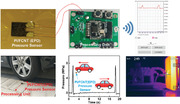- Record: found
- Abstract: found
- Article: found
Hierarchical Network Enabled Flexible Textile Pressure Sensor with Ultrabroad Response Range and High‐Temperature Resistance

Read this article at
Abstract
Thin, lightweight, and flexible textile pressure sensors with the ability to detect the full range of faint pressure (<100 Pa), low pressure (≈KPa) and high pressure (≈MPa) are in significant demand to meet the requirements for applications in daily activities and more meaningfully in some harsh environments, such as high temperature and high pressure. However, it is still a significant challenge to fulfill these requirements simultaneously in a single pressure sensor. Herein, a high‐performance pressure sensor enabled by polyimide fiber fabric with functionalized carbon‐nanotube (PI/FCNT) is obtained via a facile electrophoretic deposition (EPD) approach. High‐density FCNT is evenly wrapped and chemically bonded to the fiber surface during the EPD process, forming a conductive hierarchical fiber/FCNT matrix. Benefiting from the large compressible region of PI fiber fabric, abundant yet firm contacting points and high elastic modulus of both PI and CNT, the proposed pressure sensor can be customized and modulated to achieve both an ultra‐broad sensing range, long‐term stability and high‐temperature resistance. Thanks to these merits, the proposed pressure sensor could monitor the human physiological information, detect tiny and extremely high pressure, can be integrated into an intelligent mechanical hand to detect the contact force under high‐temperature.
Abstract
High‐performance pressure sensor enabled by polyimide fiber fabric with functionalized carbon‐nanotube (PI/FCNT) via a facile electrophoretic deposition approach is reported. Benefiting from the large compressible region of PI fiber fabric, abundant yet firm contacting points and high elastic modulus of both PI and CNT, the proposed pressure sensor achieves both an ultra‐broad sensing range, long‐term stability and high‐temperature resistance.
Related collections
Most cited references1
- Record: found
- Abstract: not found
- Book: not found
